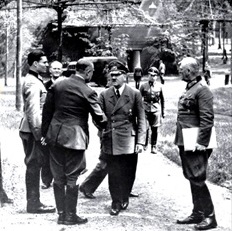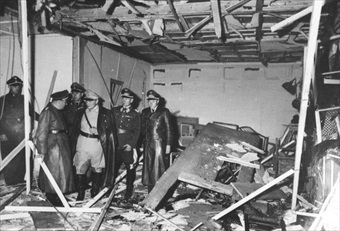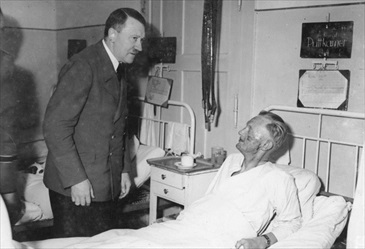HITLER ESCAPES ASSASSIN’S BOMB
Berlin, Germany • March 21, 1943
Adolf Hitler was the target of assassins on at least 30 occasions. On this date in 1943 in the German Reich’s capital, Berlin, Army officers made the second of 2 attempts in March to kill Hitler with a bomb. The week before, 2 staff officers had planted a bomb aboard Hitler’s private airplane. The plastic explosives were contained in a package supposedly containing bottles of brandy for a member of Hitler’s staff at the Wolfsschanze (Wolf’s Lair), Hitler’s remote, high-security command post at Rastenburg in East Prussia. (Rastenburg, now called Kętrzyn, is in today’s Poland.) The detonator failed to go off. In the attempt on this date, March 21, 1943, Hitler left the exhibition hall showcasing captured Soviet war booty before the bomb could go off. The officer on the suicide mission flushed the detonator down the toilet in a men’s room. Eight months later, in November 1943, a young army officer volunteered to blow himself up while modeling a new military greatcoat in front of Hitler, only to learn that Hitler had cancelled the meeting. Another assassination attempt that same month when modeling new Army winter uniforms in Hitler’s presence at the Wolf’s Lair came to nothing when the the railway truck containing the new uniforms was destroyed in an Allied air raid on Berlin.
By the summer of 1944 some senior figures in the Wehrmacht (German military) despaired that Hitler was dooming Germany to defeat on both the Eastern and Western fronts (despite the fact that German troops were still in control of much of Europe), and that the Western powers at least might be open to negotiate a conditional German surrender once Hitler was out of the picture and before the Soviet Army had a chance to overrun their country and the rest of Central and Eastern Europe. From this belief the July 20, 1944, bomb plot, codenamed “Valkyrie” (German, “Walkuere”) developed. Plotters included Adm. Wilhelm Canaris, the 57‑year-old head of the Abwehr (military intelligence); retired Col. Gen. Ludwig Beck, whom the plotters tapped to succeed Hitler as the new head of state; Maj. Gen. Baron Henning von Tresckow, who had been involved in the brandy bottles plot; and 37‑year-old Col. Claus Schenk Graf von Stauffenberg, handsome scion of a landed gentry military family, disabled veteran of Field Marshal Erwin Rommel’s famed Afrika Korps, and since July 1 Chief of Staff to the Commander of the Replacement (Reserve) Army.
The key figure was Stauffenberg. Of all the plotters he was in regular contact with Hitler (indeed, had seen Hitler on July 14 and 15, 1944) and had gotten into Wolf’s Lair without a problem 5 days earlier. Stauffenberg’s time-bomb-stuffed brown briefcase, which he had placed at the base of a table support a few feet (a meter) away from Hitler before leaving a military briefing in a conference room to supposedly take a telephone call, exploded at 12:42 p.m. on July 20, dazing and wounding Hitler, who was bent low, elbows on the table, for a better view of a situation map. The bright-yellow explosion, sounding for all the world like a 150 mm incoming howitzer blast, burst Hitler’s eardrums, burned the hair off the back of his scalp, burned his calf, and sent him flying across the room where he landed against a door “dizzy and slightly dazed” as he recalled and covered by a small pile of wooden slats and beams. Of the 24 people (generals, officers, and aides) in the room, one died on the spot, 3 others later of their wounds. Rushing back to Berlin by airplane 300 air miles/483 kilometers away, Stauffenberg and 3 conspirators were caught and executed the same day for their roles in the near-miss assassination, the first of upwards of 5,000 people who were eventually implicated (many falsely) and killed; others were sent to concentration camps. Hitler made sure personally of Stauffenberg’s death by having his body exhumed to view it for himself.
Operation Valkyrie, the Failed July 20, 1944, Bomb Plot to Kill Adolf Hitler
 |  |
Left: Col. Claus von Stauffenberg (far left), Hitler, and Wilhelm Keitel (right), chief of the Oberkommando der Wehrmacht (OKW), or the Supreme Command of the Armed Forces, on the day of a failed assassination attempt at the Wolf’s Lair in Rastenburg (Kętrzyn, Poland) on July 15, 1944. Officers in the Wehrmacht and the Abwehr, knowing well the string of failures to eliminate Hitler and his regime, nonetheless remained convinced that only they were capable of getting close enough to the well-guarded Fuehrer to do the deed. That didn’t put a brake on disenchanted politicians, churchmen, labor leaders, and intellectuals being drawn into alliances and plots, including the July 1944 conspiracy, to decapitate the Nazi leadership.
![]()
Right: Wolf’s Lair wooden, thinly walled conference hut (Lagebaracke) soon after the explosion of Stauffenberg’s 2‑pound/0.9‑kilogram plastic-explosive bomb. Due to July’s hot and humid weather the military briefing was moved from Hitler’s own underground concrete bunker to the Wolf’s Lair main room, its windows open against the oppressive heat. (An explosion in the encased bunker would have killed everyone.) Showing visitors the damaged room, which had been refurbished just days earlier, is Reichsmarschal and Luftwaffe chief Hermann Goering in the khaki uniform. The shattered room leaves little argument as to why Stauffenberg believed Hitler was dead. Neither Goering nor Reichsfuehrer Heinrich Himmler, the 2 top-ranking officials in the Nazi regime, was in the conference room when Stauffenberg’s bomb exploded.
 |  |
Left: Hitler making a hospital call on Rear Adm. Karl-Jesko von Puttkamer, a naval adjutant to Hitler and a victim of the July 1944 bombing. Twenty people were injured in the blast, 2 seriously, 4 dying. Hitler, his uniform jacket and trousers torn, was lucky to have suffered only a broken eardrum. Puttkamer, who suffered a knee injury, along with others who were injured or died from the effects of the explosion, were recipients of a special July 20 Wound Badge personally designed by Hitler. The solid hallmarked silver badge, based on the common Wound Badge that originated during the First World War, bore a facsimile of Hitler’s signature below a helmet and the date “20 Juli 1944,” a date Hitler believed to be a “moment of destiny” for him.
![]()
Right: Tenth anniversary stamp memorializing the failed assassination of Hitler in July 1944. Pictured on the stamp is Richard Scheibe’s statue “Memorial to the Victims of July 20, 1944,” which stands in the courtyard of the Bendlerblock, site of Stauffenberg’s execution by 10 riflemen and 1 officer, a lieutenant. Located now on Stauffenbergstrasse in the Tiergarten district of Berlin, the Bendlerblock was used by several departments of the OKW, including Adm. Canaris’ Abwehr. Today the building complex serves as a secondary seat of the German Federal Ministry of Defense. Valkyrie, a cinematic retelling of the officers’ plot to assassinate Hitler and replace his regime with a new German government, was released in late 2008, starring the American actor Tom Cruise.
History Channel’s Operation Valkyrie: The Plot to Kill Adolf Hitler
![]()

 History buffs, there is good news! The Daily Chronicles of World War II is now available as an ebook for $4.99 on Amazon.com. Containing a year’s worth of dated entries from this website, the ebook brings the story of this tumultuous era to life in a compelling, authoritative, and succinct manner. Featuring inventive navigation aids, the ebook enables readers to instantly move forward or backward by month and date to different dated entries. Simple and elegant! Click
History buffs, there is good news! The Daily Chronicles of World War II is now available as an ebook for $4.99 on Amazon.com. Containing a year’s worth of dated entries from this website, the ebook brings the story of this tumultuous era to life in a compelling, authoritative, and succinct manner. Featuring inventive navigation aids, the ebook enables readers to instantly move forward or backward by month and date to different dated entries. Simple and elegant! Click 











